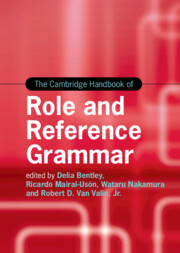Book contents
- The Cambridge Handbook of Role and Reference Grammar
- Cambridge Handbooks in Language and Linguistics
- The Cambridge Handbook of Role and Reference Grammar
- Copyright page
- Dedication
- Contents
- Figures
- Tables
- Contributors
- Pedagogical Guide to The Cambridge Handbook of Role and Reference Grammar
- Introduction
- Part One Overview
- 1 Principles of Role and Reference Grammar
- Part Two Topics in RRG: Simple Sentences
- Part Three Topics in RRG: Complex Sentences
- Part Four Applications of RRG
- Part Five Grammatical Sketches
- Index
- References
1 - Principles of Role and Reference Grammar
from Part One - Overview
Published online by Cambridge University Press: 08 June 2023
- The Cambridge Handbook of Role and Reference Grammar
- Cambridge Handbooks in Language and Linguistics
- The Cambridge Handbook of Role and Reference Grammar
- Copyright page
- Dedication
- Contents
- Figures
- Tables
- Contributors
- Pedagogical Guide to The Cambridge Handbook of Role and Reference Grammar
- Introduction
- Part One Overview
- 1 Principles of Role and Reference Grammar
- Part Two Topics in RRG: Simple Sentences
- Part Three Topics in RRG: Complex Sentences
- Part Four Applications of RRG
- Part Five Grammatical Sketches
- Index
- References
Summary
This chapter presents the fundamental theoretical principles of Role and Reference Grammar. The exposition does not presuppose any previous familiarity with RRG, and it ties in with the relevant chapters in the Handbook. After a discussion of theoretical assumptions, the theory of syntactic structure, including clauses, phrases and words, is presented in detail, with new data not found in previous expositions of the theory. The presentation includes the structure of both simple and complex sentences. The next major section concerns semantic representation, and this includes the representation of simple clauses, semantics roles and interclausal semantic relations. There follows a very short mention of the notion of information structure; the reader is referred to two other chapters which present these ideas in detail. The final section concerns the linking between syntax and semantics in simple and complex sentences. The issue of representing language-specific vs. cross-linguistically valid grammatical information is a major theme of this section. RRG’s approach involving constructional schemata is quite distinct from that of mainstream construction grammar.
Keywords
- Type
- Chapter
- Information
- The Cambridge Handbook of Role and Reference Grammar , pp. 17 - 178Publisher: Cambridge University PressPrint publication year: 2023
References
- 5
- Cited by

